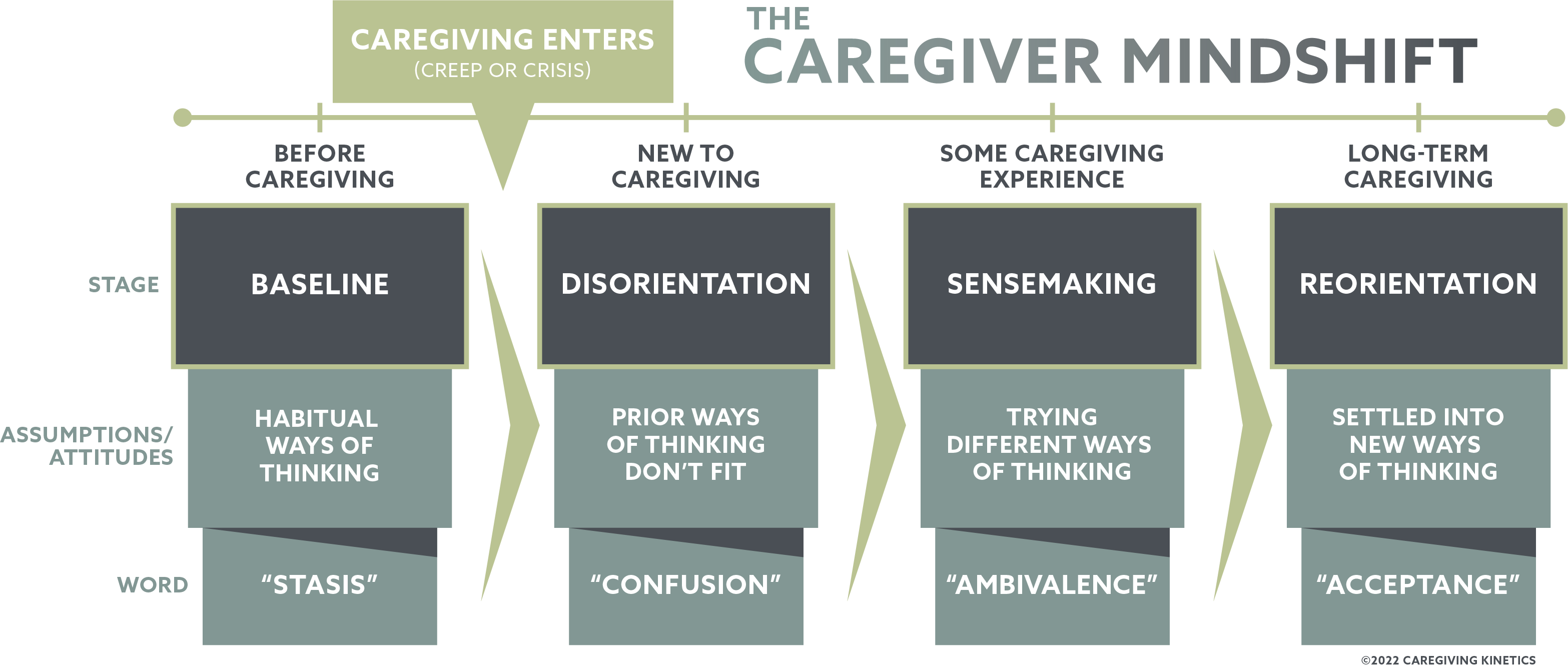
Published on:
In response to this blog article about how caregiving changes attitudes, a support group facilitator wrote to tell me that she spent an entire session discussing the topic with her caregivers. The article notes that while each caregiving journey is unique and personal, caregivers pass through a series of attitudinal adjustments that loosely align with stages of experience in the care-related role.
Feedback from the caregiver support group facilitator prompted me to develop a conceptual framework that describes the transformation caregiving can have on a person’s cognitive processes. The result of my efforts is The Caregiver Mindshift Model, which I’m pleased to share with you here.
The Caregiver Mindshift Model describes life before caregiving as “stasis” because your patterns of thinking, doing, and being with your loved one became stable and well-established over the history of your relationship and life together. I call this the “Baseline” stage because it forms a basis for comparison with your life and your way of thinking after caregiving.
Baseline patterns of life and thinking begin to change after caregiving enters into the relationship. In this regard, there are two paths leading to the onset of any care-related responsibilities you may assume for your loved one: The Creep and The Crisis.
The Creep happens slowly, as you start offering minor assistance to your loved one without thinking much of it. Perhaps your initial assistance begins with trickier tasks like bill paying, or maybe your loved one simply needs an extra hand getting in and out of the car. No matter how it starts, over time, additional care-related tasks creep into your relationship. You eventually discover that you’re spending more time helping your loved one with tasks that they used to do independently, and you may reluctantly begin to view yourself as a caregiver.
The Crisis happens abruptly, without any prior notice, and it can dramatically change your life. The Crisis is prompted by your loved one’s major medical event, which could be a life-altering diagnosis or injury. Your loved one absolutely needs you, and you suddenly find yourself in the role of caregiver, whether you like it or not, without any significant time to ramp up to the responsibilities thrust upon you. Here all the attention is on the immediate needs of your loved one, causing you to assume responsibilities that you may have never considered before, profoundly impacting you and your family.
The point is that whether your caregiving path began with The Creep or The Crisis, your assumption of responsibilities for your loved one ushers in a change to the dynamics of your relationship—which will produce corresponding changes in your ways of thinking about not only the relationship but also quite possibly your life.
The transformative thinking that occurs after caregiving is what I call The Caregiver Mindshift. The Caregiver Mindshift Model depicts three cognitive stages which loosely align with the length of experience in family caregiving.
- “Disorientation” is the first stage precipitated by the onset of caregiving. New caregivers often report feelings of disorientation and worry, aware that things are changing but afraid of what the future may hold. They discover that their prior ways of thinking about their relationship and/or life may no longer apply. Resistance, reluctance, or confusion are common responses to the emergent circumstances of their lives.
- “Sensemaking” is the stage that follows Disorientation. After a while, family caregivers with some experience have adjusted to many of the changes imposed by caregiving, but they often continue to struggle with a life in abeyance. They may find themselves “trying out” different ways of thinking about their relationship and/or life. Such caregivers can feel like ambivalent fence-sitters, caught between what used to be and what is yet to come.
- “Reorientation” represents an enduring cognitive shift which settles in after Disorientation and Sensemaking. Veteran caregivers, those who have answered the call to care over an expansive period of time, have usually reconfigured their lives to be available to a loved one in need. By now, outdated cognitive processes have yielded to an acceptance of reality and the adoption of ways of thinking which better fit their relationship and/or life today.
Admittedly, I’ve attempted to distill complex cognitive processes into a straightforward model that is easy to understand. The model may be an oversimplification, but it has been shown to resonate with family caregivers.
I offer The Caregiver Mindshift Model because raising consciousness of cognition can become an integral part of learning and growth. I’d encourage caregivers and professionals who offer support to consider how thinking evolves over the course of personal caregiving experience. Therein may be found the key to long-term success in a family caregiving role.
—————————————————————————————————————————————–
If you’d like to invite Dr. Blight to speak to your group, please contact us.
Posted in Family Caregiving






